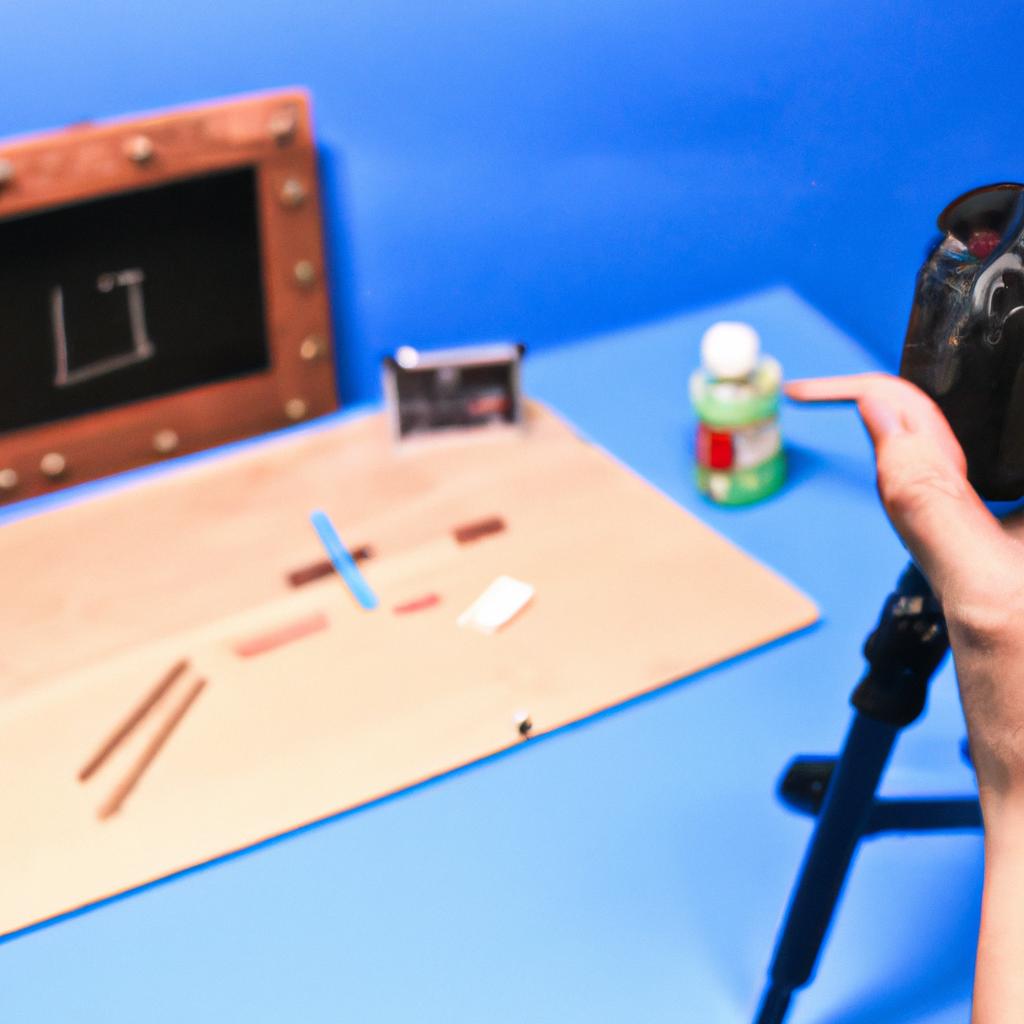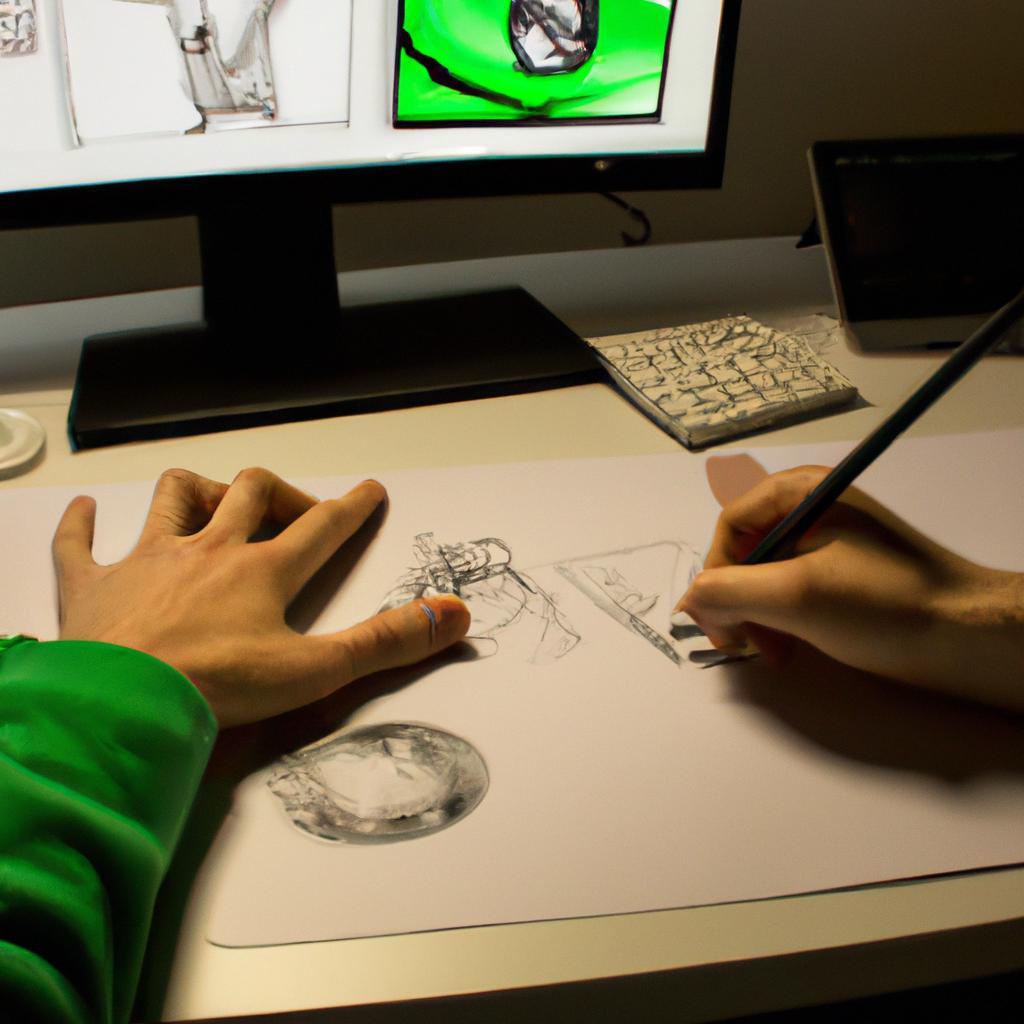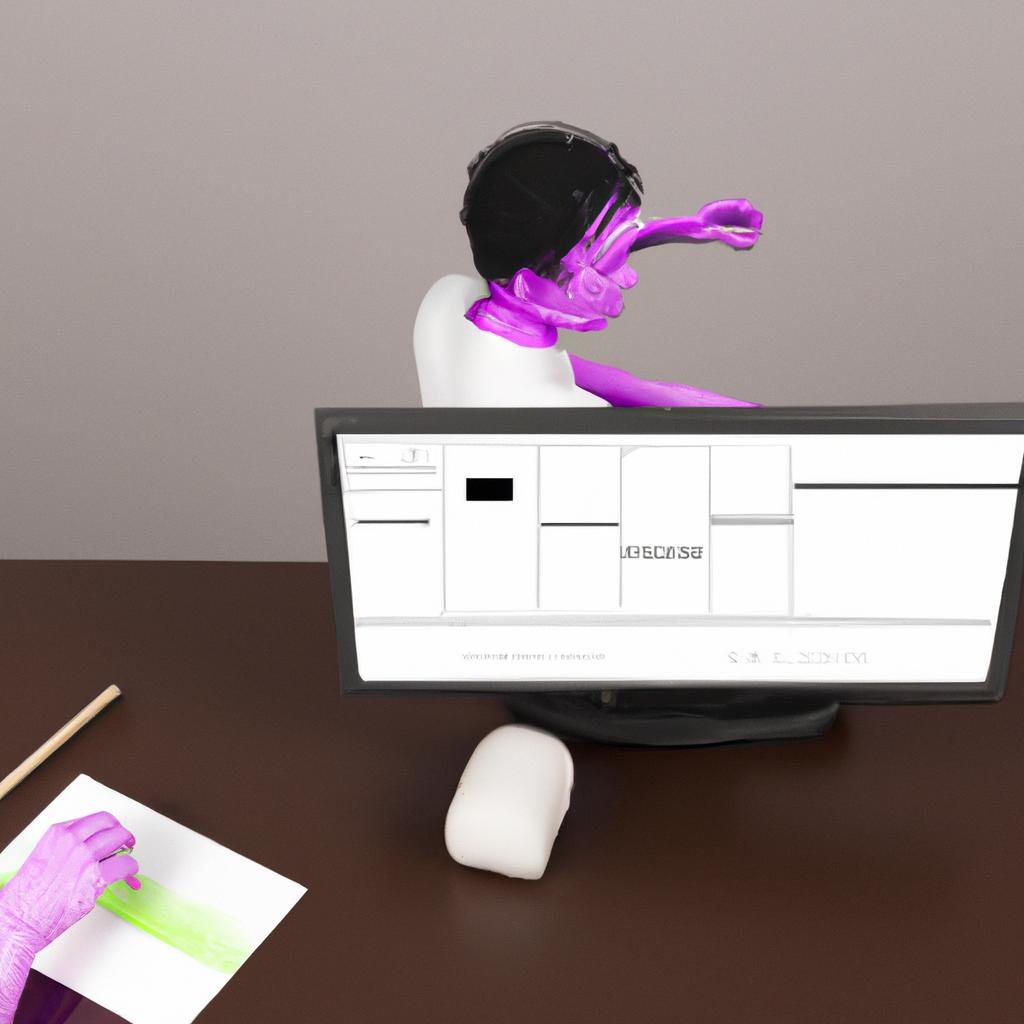Digital Illustration has revolutionized the field of Arts and Illustration, providing artists with a wide range of techniques to create captivating animations. One such technique is the use of motion capture technology, which allows artists to translate real-life movements into digital characters. For instance, imagine an artist using motion capture to animate a character performing complex martial arts moves. This not only enhances the realism of the animation but also saves time and effort by eliminating the need for manual frame-by-frame drawing.
Another important aspect of digital illustration in animation is the use of 3D modeling software. By creating three-dimensional models of characters, objects, and environments, artists can achieve a higher level of visual depth and dimensionality in their animations. These models can then be manipulated and animated using various tools within the software, allowing for greater creativity and flexibility in bringing illustrations to life on screen. For example, an artist could utilize 3D modeling software to design intricate architectural structures that seamlessly blend into fantastical landscapes for a fantasy film or video game.
Overall, digital illustration offers countless possibilities for animators and illustrators alike to push boundaries and unlock new levels of artistic expression through innovative animation techniques. In this article, we will explore some key aspects of digital illustration in arts and illustration specifically , focusing on its impact on storytelling, the integration of traditional art techniques, and the potential for collaboration between artists.
Understanding digital illustration
Digital illustration is a powerful tool that has revolutionized the field of arts and illustration. It allows artists to create stunning visual representations using various animation techniques. To comprehend the significance of digital illustration, let us consider an example: Imagine an artist who wants to bring his character designs to life through animation. With traditional methods, this process would be time-consuming and labor-intensive. However, with the advent of digital illustration, he can effortlessly animate his characters and breathe life into them in a fraction of the time.
To fully understand the potential of digital illustration, it is essential to explore its key features. Firstly, one notable advantage is the ability to manipulate and edit artwork easily. Artists can make precise adjustments without compromising the overall quality of their illustrations. Secondly, digital tools provide endless possibilities for adding special effects such as lighting and textures to enhance the visual appeal of the artwork. Additionally, these tools offer flexibility in terms of color palettes and gradients, enabling artists to experiment with different tones and moods.
To evoke an emotional response from viewers, consider these aspects:
- The vibrant colors used in digital illustrations can invoke feelings of joy and excitement.
- The seamless blending techniques enable smooth transitions between elements within the artwork.
- The dynamic nature of animations created through digital illustration evokes a sense of energy and movement.
- The intricate details achievable through digital tools captivate viewers’ attention and foster a sense of wonder.
In addition to these features, another noteworthy aspect is how digital illustration promotes collaboration among artists by allowing easy sharing and editing capabilities. This fosters creativity as multiple perspectives can be incorporated into a single project seamlessly.
As we delve further into exploring different art styles in subsequent sections, it becomes evident that understanding digital illustration forms a solid foundation for artists seeking to expand their creative horizons beyond conventional boundaries
Exploring different art styles
Exploring the World of Animation: Techniques in Digital Illustration
Having gained a comprehensive understanding of digital illustration, we now delve into the realm of animation techniques and its application within this artistic field. To illustrate the potential that lies within these techniques, let us consider an example: imagine a digital illustrator who wants to bring their static illustrations to life through captivating animations. By employing various animation techniques, they can create dynamic visuals that engage viewers on multiple levels.
When it comes to animation in digital illustration, there are several key techniques that artists often utilize:
- Frame-by-Frame Animation: This technique involves creating individual frames with slight variations in each frame, which when played together at high speed, creates fluid motion.
- Motion Tweening: Through motion tweening, illustrators can establish smooth transitions between two or more keyframes, allowing for seamless movement of objects or characters.
- Shape Morphing: With shape morphing, artists can transform one shape into another smoothly over time by manipulating anchor points and paths.
- Puppet Animation: Utilizing rigging tools and skeletal structures, puppet animation enables illustrators to animate characters by controlling different parts independently while maintaining realistic movements.
To further explore these concepts visually, refer to the following table showcasing emotions evoked by specific animation techniques:
| Technique | Emotion Evoked |
|---|---|
| Frame-by-Frame | Excitement |
| Motion Tweening | Elegance |
| Shape Morphing | Transformation |
| Puppet Animation | Playfulness |
Incorporating these techniques into digital illustration opens up endless possibilities for creativity and storytelling. Animations have the power to breathe life into still images and convey messages in ways that captivate audiences worldwide.
Transitioning seamlessly from exploring animation techniques leads us naturally to our next section—utilizing color and composition—to enhance the impact of digital illustrations even further. By combining the principles of color theory and composition, artists can create visually stunning pieces that engage viewers on a deeper level.
Utilizing color and composition
Exploring Different Art Styles
In the previous section, we delved into the diverse world of art styles and their significance within digital illustration. Now, let us shift our focus towards another crucial aspect in the realm of animation techniques: utilizing color and composition to enhance visual storytelling.
To illustrate this point, imagine a hypothetical scenario where an artist is creating a digital illustration for an animated movie scene depicting a mystical forest at dusk. By carefully selecting colors that reflect the ethereal atmosphere and combining them with thoughtful composition, the artist can effectively convey a sense of enchantment and intrigue to captivate viewers.
When it comes to leveraging color and composition in digital illustration for animation purposes, there are several key considerations:
- Color psychology: Colors evoke different emotions and moods in individuals. By choosing appropriate hues based on the intended narrative or character traits, animators can elicit specific emotional responses from their audience.
- Contrast and balance: The interplay between light and dark shades promotes depth and dimensionality within illustrations. Achieving harmony through balanced placement of elements enhances overall aesthetic appeal.
- Rule of thirds: Dividing the canvas into thirds both vertically and horizontally provides guidelines for placing focal points or subjects off-center. This technique adds visual interest by breaking away from traditional centered compositions.
- Visual hierarchy: Establishing a clear visual hierarchy ensures that important elements stand out while maintaining a cohesive flow throughout the artwork.
To further illustrate these concepts, consider the following table showcasing how different color schemes can evoke distinct emotional responses:
| Color Scheme | Emotional Response |
|---|---|
| Monochromatic | Calmness |
| Complementary | Energy |
| Analogous | Harmony |
| Triadic | Vibrancy |
By thoughtfully incorporating various animation techniques such as color psychology, contrast, rule of thirds, and visual hierarchy into digital illustrations, artists have the power to truly bring their creations to life. In the subsequent section on “Mastering digital drawing techniques,” we will explore the technical skills required to execute these concepts seamlessly, ensuring an immersive and captivating visual experience for audiences worldwide.
Mastering digital drawing techniques
Building upon the foundation of color and composition, mastering digital drawing techniques is essential for artists and illustrators seeking to create captivating animations. By honing these skills, creators can bring their designs to life and captivate audiences with dynamic visuals. For instance, imagine an artist who has mastered the art of shading and highlighting in a digital illustration. This expertise allows them to add depth and dimensionality to characters or objects, making them appear more realistic on screen.
One key aspect of mastering digital drawing techniques is understanding how different tools and brushes can be utilized to achieve desired effects. Artists may experiment with various brush types, textures, and opacity settings to create unique visual styles that enhance their storytelling. Additionally, they must develop proficiency in using layers effectively – organizing elements within separate layers enables greater control over individual components while maintaining overall cohesiveness.
To evoke an emotional response in viewers through animation, artists should consider incorporating the following aspects into their work:
- Expressive character movements: Conveying emotions through fluid gestures and body language adds depth and relatability to animated characters.
- Dynamic camera angles: Utilizing creative camera perspectives enhances dramatic moments or emphasizes specific details, creating a sense of excitement or intrigue.
- Atmospheric lighting: Manipulating light sources can set moods, emphasizing certain areas or creating contrasting shadows for added impact.
- Effective sound design: Introducing appropriate background music or sound effects heightens the overall immersive experience for viewers.
| Aspect | Description | Example |
|---|---|---|
| Expressive Movements | Characters’ actions reflect their emotions; fluidity in motion brings authenticity and connection between audience members | A character’s joyful dance showcasing exuberance |
| Dynamic Camera Angles | Strategic choice of camera position creates intriguing viewpoints; it guides attention towards important story elements | An upward angle revealing a towering figure |
| Atmospheric Lighting | Manipulation of lighting creates atmosphere; it can evoke suspense, intimacy, or highlight specific moments within an animation | Harsh shadows cast by a flickering candle in a dark room |
| Effective Sound Design | The use of suitable background music and sound effects enhances emotional impact and immersion for viewers | A crescendoing score accompanying a climactic scene |
By mastering digital drawing techniques and incorporating these captivating elements into their animations, artists can create immersive experiences that resonate with audiences. In the subsequent section about “Creating depth and perspective,” we will explore how artists utilize various techniques to give their illustrations a three-dimensional feel without solely relying on color or composition.
Creating depth and perspective
Building upon the mastery of digital drawing techniques, artists can explore animation techniques to bring their illustrations to life. By incorporating movement and motion into static images, animators can create captivating storytelling experiences that engage viewers on a deeper level. One example is the use of frame-by-frame animation, where each individual image is carefully crafted to seamlessly transition from one frame to another.
Paragraph 1:
Frame-by-frame animation involves creating a series of consecutive drawings or frames that are played back rapidly, giving the illusion of motion. This technique requires meticulous attention to detail as artists must consider every aspect of the illustration’s movement. Whether it’s a character walking across the screen or objects falling with gravity, each frame contributes to telling a visually compelling story. Artists often utilize software applications like Adobe Animate or Toon Boom Harmony to streamline this process and add professional polish to their animations.
Paragraph 2:
To effectively convey emotion and enhance engagement in animated illustrations, artists can employ various techniques:
- Timing and spacing: The timing between frames can greatly impact how an object moves on-screen. Deliberate variations in spacing give characters weight and contribute to realistic movements.
- Squash and stretch: This principle exaggerates deformations within an object during its motion, adding elasticity and enhancing visual appeal.
- Anticipation and follow-through: Including anticipation before an action occurs and subtle movements after it concludes creates more natural-looking animations.
- Secondary motions: Incorporating secondary actions such as hair swaying or clothing ripples adds dimensionality and realism to characters.
- Captivating audiences through dynamic illustrations
- Eliciting empathy by conveying emotions through movement
- Creating immersive worlds that transport viewers into imaginative narratives
- Stimulating curiosity and wonder through non-linear storytelling
Paragraph 3:
Animation techniques enable artists to push artistic boundaries further while breathing life into their creations. By mastering frame-by-frame animation and understanding the principles that govern movement, artists can create captivating illustrations that resonate with viewers on an emotional level.
Building upon animation techniques, let us now delve into enhancing illustrations with digital effects to unlock new dimensions of creativity.
Enhancing illustrations with digital effects
Creating depth and perspective in digital illustration is a crucial aspect of bringing life to flat images. By incorporating various animation techniques, artists can enhance their illustrations and evoke emotions in the audience. In this section, we will explore how these techniques are used to create dynamic and captivating visuals.
One example of using animation techniques to create depth and perspective is the use of parallax scrolling. This technique involves separating different elements of an image into layers that move at different speeds when scrolled or animated. For instance, imagine a digital illustration depicting a serene forest scene. The foreground layer may feature trees and bushes moving slowly as if they are closer to the viewer, while the background layer could depict mountains fading into the distance with slower movement. This creates a sense of depth and immersion for the audience, making them feel like they are truly exploring the environment.
In addition to parallax scrolling, other animation techniques such as zooming, panning, and rotating can also be employed to add depth and perspective to digital illustrations. These techniques allow artists to guide the viewers’ attention towards specific details within their artwork by creating movements that draw focus or reveal hidden elements gradually. An artist might use zooming to emphasize intricate patterns on a character’s clothing or employ panning to showcase a vast landscape unfolding before the eyes of the audience.
- Animation brings static illustrations to life.
- Dynamic movement adds excitement and engagement.
- Depth perception immerses viewers in the visual world created.
- Emotions evoked through motion leave lasting impressions.
Now let’s take a look at how these animation techniques can transform an ordinary digital illustration into something extraordinary:
| Technique | Description | Example |
|---|---|---|
| Parallax | Layers moving at different speeds create depth | Forest scene with varying speed for foreground layers |
| Zooming | Focuses on specific details by increasing or decreasing size | Character’s intricate clothing patterns |
| Panning | Reveals hidden elements within an artwork through lateral movement | Unfolding vast landscape before the audience |
By incorporating animation techniques such as parallax scrolling, zooming, panning, and rotating into their digital illustrations, artists can create visually captivating experiences for their viewers. These techniques enable the artist to add depth and perspective to static images, bringing them to life and evoking emotions in the audience. By carefully considering how each technique enhances different aspects of an illustration, artists can effectively engage viewers and leave a lasting impact without relying solely on traditional static imagery.
 PSP Oste
PSP Oste



